Window installation is a critical aspect of construction and home improvement that significantly impacts energy efficiency, aesthetics, and structural integrity. Properly installed windows enhance the comfort of living spaces, reduce energy costs, and contribute to the overall value of a property. This article delves into the theoretical underpinnings of window installation, exploring various techniques, materials, and best practices that ensure optimal performance and longevity.
Understanding Window Types
Before delving into installation techniques, it is essential to recognize the different types of windows available. The most common types include:
- Casement Windows: Hinged on one side, these windows open outward, providing excellent ventilation and unobstructed views.
- Double-Hung Windows: Featuring two operable sashes, these windows can be opened from the top or bottom, allowing for versatile airflow.
- Sliding Windows: These windows slide horizontally and are ideal for spaces with limited vertical clearance.
- Awning Windows: Hinged at the top, these windows open outward, allowing for ventilation even during rain.
- Fixed Windows: Non-operable windows that provide views and light without ventilation.
Preparing for Installation
Preparation is key to successful window installation. The following steps are crucial:
- Measurement: Accurate measurements of the window opening are essential. The width and height should be measured at three points (top, middle, bottom for width; left, center, right for height) to account for any irregularities in the opening.
- Choosing the Right Window: Based on the measurements, select windows that fit the specific dimensions. Consider energy efficiency ratings, materials, and styles that complement the architectural design of the building.
- Gathering Tools and Materials: Essential tools include a measuring tape, level, square, caulking gun, hammer, screwdriver, and safety equipment. Materials may include flashing, insulation, shims, and sealants.
Installation Techniques
The installation process can vary based on window type and the existing structure, but the general steps are as follows:
- Removing Old Windows: If replacing existing windows, carefully remove the old units. This may involve prying off trim, removing screws or nails, and taking care not to damage the surrounding structure.
- Preparing the Opening: Clean the window opening of debris and ensure that it is square and level. Any rot or damage to the frame should be repaired before proceeding.
- Dry Fitting: Place the new window into the opening without fastening it to check the fit. Use shims to ensure it is level and plumb, adjusting as necessary.
- Securing the Window: Once satisfied with the fit, secure the window according to the manufacturer's instructions. This often involves fastening screws through the window frame into the surrounding structure.
- Insulation and Sealing: After the window is secured, insulation is added around the frame to prevent air and water infiltration. This can be done using foam insulation or fiberglass. Following insulation, apply a high-quality sealant around the exterior perimeter to create a waterproof barrier.
- Finishing Touches: Install any necessary trim or casing to complete the look. Interior trim should be applied to cover any gaps and provide a polished finish.
Material Considerations
The choice of materials plays a significant role in the performance of windows. Common materials include:

- Vinyl: Known for its durability and low maintenance, vinyl windows are energy-efficient and available in various styles and colors.
- Wood: Offering a classic aesthetic, wood windows provide excellent insulation but require regular maintenance to prevent rot and warping.
- Aluminum: Lightweight and strong, aluminum windows are resistant to corrosion but may require thermal breaks to improve energy efficiency.
- Fiberglass: This material is exceptionally durable and energy-efficient, though often more expensive than other options.
Energy Efficiency and Building Codes
Energy efficiency is a critical consideration in window installation. Many regions have building codes that mandate specific energy efficiency standards. Windows are rated based on their U-factor (insulation performance) and solar heat gain coefficient (SHGC). Selecting windows that meet or exceed these standards can lead to significant energy savings and improved comfort.
Common Challenges in Window Installation
Even with careful planning and execution, several challenges may arise during installation:
- Improper Measurements: Inaccurate measurements can lead to ill-fitting windows, resulting in air leaks and energy loss.
- Water Infiltration: Failure to properly seal and flash windows can lead to water damage and mold growth.
- Structural Issues: Existing structural problems may complicate installation, https://psbios.com/window-replacement-in-watford-balancing-aesthetics-and-efficiency requiring additional repairs before new windows can be installed.
Conclusion
Window installation is a multifaceted process that requires careful planning, precise execution, and a thorough understanding of materials and techniques. By adhering to best practices and considering factors such as energy efficiency and local building codes, homeowners and contractors can ensure that windows are installed correctly, enhancing the comfort, aesthetics, and value of a property. As technology advances, new materials and installation methods will continue to evolve, making it imperative for industry professionals to stay informed and adaptable. Ultimately, investing in proper window installation pays dividends in energy savings, improved functionality, and long-lasting beauty.








